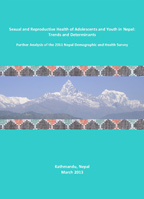- PUBLICATIONS
- JOURNAL ARTICLES
- ACCESS PUBLICATIONS
Publications Summary
- Document Type
- Further Analysis
- Publication Topic(s)
- Fertility and Fertility Preferences, Youth
- Country(s)
- Nepal
- Survey
- Nepal DHS, 2011
- Language
- English
- Recommended Citation
- Khatiwada, Naresh, Pushkar Raj Silwal, Rajendra Bhadra, and Tirhta Man Tamang 2013. Sexual and Reproductive Health of Adolescents and Youth In Nepal: Trends and Determinants: Further Analysis of the 2011 Nepal Demographic and Health Survey. DHS Further Analysis Reports No. 76. Calverton, Maryland, USA: Nepal Ministry of Health and Population, New ERA, and ICF International.
- Download Citation
- RIS format / Text format / Endnote format
- Publication Date
- March 2013
- Publication ID
- FA76
Download
 Sexual and Reproductive Health of Adolescents and Youth in Nepal: Trends and Determinants (PDF, 1260K)
Sexual and Reproductive Health of Adolescents and Youth in Nepal: Trends and Determinants (PDF, 1260K)
Download this publication
There is no printed copy available to order.
